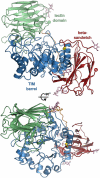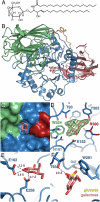Insights into Krabbe disease from structures of galactocerebrosidase
- PMID: 21876145
- PMCID: PMC3174575
- DOI: 10.1073/pnas.1105639108
Insights into Krabbe disease from structures of galactocerebrosidase
Abstract
Krabbe disease is a devastating neurodegenerative disease characterized by widespread demyelination that is caused by defects in the enzyme galactocerebrosidase (GALC). Disease-causing mutations have been identified throughout the GALC gene. However, a molecular understanding of the effect of these mutations has been hampered by the lack of structural data for this enzyme. Here we present the crystal structures of GALC and the GALC-product complex, revealing a novel domain architecture with a previously uncharacterized lectin domain not observed in other hydrolases. All three domains of GALC contribute residues to the substrate-binding pocket, and disease-causing mutations are widely distributed throughout the protein. Our structures provide an essential insight into the diverse effects of pathogenic mutations on GALC function in human Krabbe variants and a compelling explanation for the severity of many mutations associated with fatal infantile disease. The localization of disease-associated mutations in the structure of GALC will facilitate identification of those patients that would be responsive to pharmacological chaperone therapies. Furthermore, our structure provides the atomic framework for the design of such drugs.
Conflict of interest statement
The authors declare no conflict of interest.
Figures



Comment in
-
Sneak peak at galactocerebrosidase, Krabbe disease's lysosomal hydrolase.Proc Natl Acad Sci U S A. 2011 Sep 13;108(37):15017-8. doi: 10.1073/pnas.1112653108. Epub 2011 Sep 6. Proc Natl Acad Sci U S A. 2011. PMID: 21896758 Free PMC article. No abstract available.
Similar articles
-
Structural snapshots illustrate the catalytic cycle of β-galactocerebrosidase, the defective enzyme in Krabbe disease.Proc Natl Acad Sci U S A. 2013 Dec 17;110(51):20479-84. doi: 10.1073/pnas.1311990110. Epub 2013 Dec 2. Proc Natl Acad Sci U S A. 2013. PMID: 24297913 Free PMC article.
-
Late-onset Krabbe disease is predominant in Japan and its mutant precursor protein undergoes more effective processing than the infantile-onset form.Gene. 2014 Jan 25;534(2):144-54. doi: 10.1016/j.gene.2013.11.003. Epub 2013 Nov 16. Gene. 2014. PMID: 24252386
-
Molecular Mechanisms of Disease Pathogenesis Differ in Krabbe Disease Variants.Traffic. 2016 Aug;17(8):908-22. doi: 10.1111/tra.12404. Epub 2016 May 30. Traffic. 2016. PMID: 27126738 Free PMC article.
-
Krabbe disease: New hope for an old disease.Neurosci Lett. 2021 May 1;752:135841. doi: 10.1016/j.neulet.2021.135841. Epub 2021 Mar 22. Neurosci Lett. 2021. PMID: 33766733 Free PMC article. Review.
-
Splicing mutations of GALC in adult patient with adult-onset Krabbe disease: case report and review of literature.Neurocase. 2024 Apr;30(2):63-67. doi: 10.1080/13554794.2024.2354541. Epub 2024 May 18. Neurocase. 2024. PMID: 38762762 Review.
Cited by
-
Chaperone therapy for Krabbe disease: potential for late-onset GALC mutations.J Hum Genet. 2015 Sep;60(9):539-45. doi: 10.1038/jhg.2015.61. Epub 2015 Jun 25. J Hum Genet. 2015. PMID: 26108143
-
Krabbe Disease: Prospects of Finding a Cure Using AAV Gene Therapy.Front Med (Lausanne). 2021 Nov 11;8:760236. doi: 10.3389/fmed.2021.760236. eCollection 2021. Front Med (Lausanne). 2021. PMID: 34869463 Free PMC article. Review.
-
Linking glycosphingolipid metabolism to disease-related changes in the plasma membrane proteome.Biochem Soc Trans. 2024 Dec 19;52(6):2477-2486. doi: 10.1042/BST20240315. Biochem Soc Trans. 2024. PMID: 39641585 Free PMC article. Review.
-
Structure of human saposin A at lysosomal pH.Acta Crystallogr F Struct Biol Commun. 2015 Jul;71(Pt 7):895-900. doi: 10.1107/S2053230X15008584. Epub 2015 Jun 27. Acta Crystallogr F Struct Biol Commun. 2015. PMID: 26144235 Free PMC article.
-
The mechanism of glycosphingolipid degradation revealed by a GALC-SapA complex structure.Nat Commun. 2018 Jan 11;9(1):151. doi: 10.1038/s41467-017-02361-y. Nat Commun. 2018. PMID: 29323104 Free PMC article.
References
-
- Suzuki K. Globoid cell leukodystrophy (Krabbe’s disease): Update. J Child Neurol. 2003;18:595–603. - PubMed
-
- Nagara H, Ogawa H, Sato Y, Kobayashi T, Suzuki K. The twitcher mouse: Degeneration of oligodendrocytes in vitro. Brain Res. 1986;391:79–84. - PubMed
-
- Tanaka K, Nagara H, Kobayashi T, Goto I. The twitcher mouse: Accumulation of galactosylsphingosine and pathology of the sciatic nerve. Brain Res. 1988;454:340–346. - PubMed
-
- Wenger DA, Rafi MA, Luzi P, Datto J, Costantino-Ceccarini E. Krabbe disease: Genetic aspects and progress toward therapy. Mol Genet Metab. 2000;70:1–9. - PubMed
-
- Rafi MA, Luzi P, Zlotogora J, Wenger DA. Two different mutations are responsible for Krabbe disease in the Druze and Moslem Arab populations in Israel. Hum Genet. 1996;97:304–308. - PubMed
Publication types
MeSH terms
Substances
Associated data
- Actions
- Actions
Grants and funding
LinkOut - more resources
Full Text Sources
Other Literature Sources
Medical
Molecular Biology Databases

